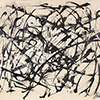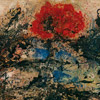Toshimitsu IMAI
Japanese 1928 - 2002
Born in 1928 Kyoto Japan, Toshimitsu Imai was trained at the Tokyo State Art Academy. His style at the earlier stage of his career was identified as Fauvism. In 1952, he won the Best New Artist Award at the 15th Shinseisaku Salon and departed Japan for Paris for study of Medieval history and philosophy. In 1955, under the influence of art critic Michel Tapié, Imai switched his creative style into abstract art. In 1953, Imai was invited to show his works at the São Paulo Biennale. In 1956, he returned to Japan for a group show. In 1960, he was invited to exhibit at the Venice Biennale. In 1962, he was recognized as an outstanding contemporary artist at The Fifth Exhibition of Japanese Contemporary Art in Tokyo and the Museum of Modern Art. Imai continued to make significant breakthroughs and became obsessed with symbolic elements. In the 1970's, Imai presented a creative series incorporating Japanese characters and cultural elements into his paintings. In the later stage of his career, he turned his focus to the Sino-Japanese War and World War II. Imai's works have been collected by the Ohara Museum of Art Japan, Japan National Museum of Art Osaka, and the National Museum of Modern Art Tokyo.

